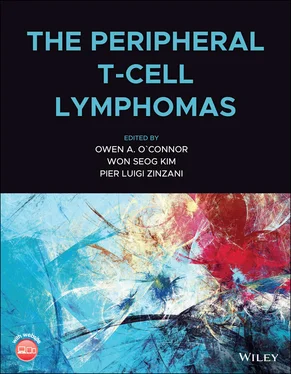16 16 Nguyen, T.B., Sakata‐Yanagimoto, M., Fujisawa, M. et al. (2020). Dasatinib is an effective treatment for angioimmunoblastic T‐cell lymphoma. Cancer Res 80 (9): 1875–1884.
17 17 Fujisawa, M., Sakata‐Yanagimoto, M., Nishizawa, S. et al. (2018). Activation of RHOA‐VAV1 signaling in angioimmunoblastic T‐cell lymphoma. Leukemia 32 (3): 694–702.
18 18 Sato, F., Ishida, T., Ito, A. et al. (2013). Angioimmunoblastic T‐cell lymphoma mice model. Leuk Res 37 (1): 21–27.
19 19 Morris, S.W., Kirstein, M.N., Valentine, M.B. et al. (1995). Fusion of a kinase gene, ALK, to a nucleolar protein gene, NPM, in non‐Hodgkin's lymphoma. Science 267 (5196): 316–317.
20 20 Kuefer, M.U., Look, A.T., Pulford, K. et al. (1997). Retrovirus‐mediated gene transfer of NPM‐ALK causes lymphoid malignancy in mice. Blood 90 (8): 2901–2910.
21 21 Miething, C., Grundler, R., Fend, F. et al. (2003). The oncogenic fusion protein nucleophosmin–anaplastic lymphoma kinase (NPM–ALK) induces two distinct malignant phenotypes in a murine retroviral transplantation model. Oncogene 22 (30): 4642–4647.
22 22 Miething, C., Grundler, R., Mugler, C. et al. (2004). A new method of retroviral lineage specific expression utilizing the Cre/lox system induces a T‐lymphoid malignancy in a mouse model of ALCL. Blood 104 (11): 348.
23 23 Chiarle, R., Gong, J.Z., Guasparri, I. et al. (2003). NPM‐ALK transgenic mice spontaneously develop T‐cell lymphomas and plasma cell tumors. Blood 101 (5): 1919–1927.
24 24 Chiarle, R., Simmons, W.J., Cai, H. et al. (2005). Stat3 is required for ALK‐mediated lymphomagenesis and provides a possible therapeutic target. Nat Med 11 (6): 623–629.
25 25 Turner, S.D., Tooze, R., Maclennan, K., and Alexander, D.R. (2003). Vav‐promoter regulated oncogenic fusion protein NPM‐ALK in transgenic mice causes B‐cell lymphomas with hyperactive Jun kinase. Oncogene 22 (49): 7750–7761.
26 26 Turner, S.D., Merz, H., Yeung, D., and Alexander, D.R. (2006). CD2 promoter regulated nucleophosmin‐anaplastic lymphoma kinase in transgenic mice causes B lymphoid malignancy. Anticancer Res 26 (5A): 3275–3279.
27 27 Rajan, S.S., Li, L., Kweh, M.F. et al. (2019). CRISPR genome editing of murine hematopoietic stem cells to create Npm1‐Alk causes ALK+ lymphoma after transplantation. Blood Adv 3 (12): 1788–1794.
28 28 Pfeifer, W., Levi, E., Petrogiannis‐Haliotis, T. et al. (1999). A murine xenograft model for human CD30+ anaplastic large cell lymphoma. Successful growth inhibition with an anti‐CD30 antibody (HeFi‐1). Am J Pathol 155 (4): 1353–1359.
29 29 Bangham, C.R.M. (2018). Human T cell leukemia virus type 1: persistence and pathogenesis. Annu Rev Immunol 36 (1): 43–71.
30 30 Nerenberg, M., Hinrichs, S.H., Reynolds, R.K. et al. (1987). The tat gene of human T‐lymphotropic virus type 1 induces mesenchymal tumors in transgenic mice. Science 237 (4820): 1324–1329.
31 31 Habu, K., Nakayama‐Yamada, J., Asano, M. et al. (1999). The human T cell leukemia virus type I‐tax gene is responsible for the development of both inflammatory polyarthropathy resembling rheumatoid arthritis and noninflammatory ankylotic arthropathy in transgenic mice. J Immunol 162 (5): 2956–2963.
32 32 Ruddle, N.H., Li, C.B., Horne, W.C. et al. (1993). Mice transgenic for HTLV‐I LTR‐tax exhibit tax expression in bone, skeletal alterations. and high bone turnover. Virology 197 (1): 196–204.
33 33 Hall, A.P., Irvine, J., Blyth, K. et al. (1998). Tumours derived from HTLV‐I tax transgenic mice are characterized by enhanced levels of apoptosis and oncogene expression. J Pathol 186 (2): 209–214.
34 34 Hasegawa, H., Sawa, H., Lewis, M.J. et al. (2006). Thymus‐derived leukemia‐lymphoma in mice transgenic for the tax gene of human T‐lymphotropic virus type I. Nat Med 12 (4): 466–472.
35 35 Grossman, W.J., Kimata, J.T., Wong, F.H. et al. (1995). Development of leukemia in mice transgenic for the tax gene of human T‐cell leukemia virus type I. Proc Natl Acad Sci U S A 92 (4): 1057–1061.
36 36 Gao, L., Deng, H., Zhao, H. et al. (2005). HTLV‐1 tax transgenic mice develop spontaneous osteolytic bone metastases prevented by osteoclast inhibition. Blood 106 (13): 4294–4302.
37 37 Satou, Y., Yasunaga, J.I., Zhao, T. et al. (2011). HTLV‐1 bZIP factor induces T‐cell lymphoma and systemic inflammation in vivo. PLoS Pathog 7 (2): e1001274.
38 38 Esser, A.K., Rauch, D.A., Xiang, J. et al. (2017). HTLV‐1 viral oncogene HBZ induces osteolytic bone disease in transgenic mice. Oncotarget 8 (41): 69250–69263.
39 39 Zhao, T., Satou, Y., and Matsuoka, M. (2014). Development of T cell lymphoma in HTLV‐1 bZIP factor and tax double transgenic mice. Arch Virol 159 (7): 1849–1856.
40 40 Kawano, N., Ishikawa, F., Shimoda, K. et al. (2005). Efficient engraftment of primary adult T‐cell leukemia cells in newborn NOD/SCID/beta2‐microglobulin(null) mice. Leukemia 19 (8): 1384–1390.
41 41 Mishra, A., La Perle, K., Kwiatkowski, S. et al. (2016). Mechanism, consequences, and therapeutic targeting of abnormal IL15 signaling in cutaneous T‐cell lymphoma. Cancer Discov 6 (9): 986–1005.
42 42 Fehniger, T.A., Suzuki, K., Ponnappan, A. et al. (2001). Fatal leukemia in interleukin 15 transgenic mice follows early expansions in natural killer and memory phenotype CD8+ T cells. J Exp Med 193 (2): 219–231.
43 43 McGirt, L.Y., Jia, P., Baerenwald, D.A. et al. (2015). Whole‐genome sequencing reveals oncogenic mutations in mycosis fungoides. Blood 126 (4): 508–519.
44 44 Cornejo, M.G., Kharas, M.G., Werneck, M.B. et al. (2009). Constitutive JAK3 activation induces lymphoproliferative syndromes in murine bone marrow transplantation models. Blood 113 (12): 2746–2754.
45 45 Rivera‐Munoz, P., Laurent, A.P., Siret, A. et al. (2018). Partial trisomy 21 contributes to T‐cell malignancies induced by JAK3‐activating mutations in murine models. Blood Adv 2 (13): 1616–1627.
46 46 Roberti, A., Dobay, M.P., Bisig, B. et al. (2016). Type II enteropathy‐associated T‐cell lymphoma features a unique genomic profile with highly recurrent SETD2 alterations. Nat Commun 7 (1): 12602–12613.
47 47 Moffitt, A.B., Ondrejka, S.L., McKinney, M. et al. (2017). Enteropathy‐associated T cell lymphoma subtypes are characterized by loss of function of SETD2. J Exp Med 214 (5): 1371–1386.
Part II Epidemiology and Classification of the PTCL
5 Geographic Distribution of the Peripheral T‐cell Lymphomas: Global Epidemiology
Amulya Yellala, Avyakta Kallam and James O. Armitage
Division of Oncology-Hematology, Department of Internal Medicine, University of Nebraska Medical Center, Omaha, NE, USA
The T‐cell lymphomas are characterized by marked differences in its global patterns of distribution.
While the endemic distribution of viruses like human T‐cell lymphotropic virus type I (HTLV1) and Epstein–Barr virus may help explain some of the geographic variability, the biological basis for the marked differences in incidence across countries is poorly understood.
T‐cell lymphomas like extranodal natural‐killer T‐cell lymphoma and HTLV1 adult T‐cell leukemia/lymphoma have a much higher incidence and prevalence in Asia and the Caribbean, and are considered relative rare in the West.
The incidence of peripheral T‐cell lymphoma may have increased over the past two decades in the United States, some fraction of which may be due to better diagnosis.
The epidemiology and classification of non‐Hodgkin lymphoma (NHL) has undergone vast transformation over the past few decades. Owing to an increase in incidence of the disease, a number of epidemiological studies were conducted, which led to a better understanding of the risk factors and the several subtypes of NHL. Despite these studies, the epidemiological data regarding peripheral T and natural killer (NK)‐cell lymphomas is limited, due to the low incidence of this disease when compared with that of B‐cell lymphomas.
Читать дальше












